Red junglefowl
| Red junglefowl | |
|---|---|
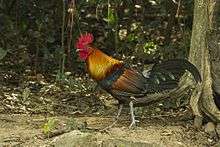 | |
| Scientific classification | |
| Kingdom: | Animalia |
| Phylum: | Chordata |
| Class: | Aves |
| Order: | Galliformes |
| Family: | Phasianidae |
| Genus: | Gallus |
| Species: | G. gallus |
| Binomial name | |
| Gallus gallus | |
 | |
| Red junglefowl range | |
| Synonyms | |
|
Phasianus gallus Linnaeus, 1758 | |
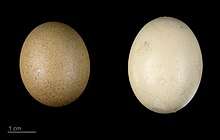
The red junglefowl (Gallus gallus) is a tropical member of the family Phasianidae. It is the primary progenitor of the domestic chicken (though genetic evidence strongly suggests some past hybridisation with the grey junglefowl, as well).[2] The red junglefowl was first domesticated at least 5000 years ago in Asia. Since then, it has spread around the world, and the domestic form is kept globally as a very productive food source of both meat and eggs.[3]
Range
The range of the wild form stretches from India, eastwards across Indochina and southern China and into Malaysia, Singapore, the Philippines, and Indonesia. Junglefowl are established on several of the Hawaiian Islands, including Kauai, but these are feral descendants of domestic chickens. They can also be found on Christmas Island, Vanuatu, and the Mariana Islands.
Each of these various regions had its own subspecies of Gallus gallus, including:
Sexual dimorphism
The male's tail is composed of long, arching feathers that initially look black, but shimmer with blue, purple, and green in good light. The female's plumage is typical of this family of birds in being cryptic and adapted for camouflage. She alone looks after the eggs and chicks. She also has no fleshy wattles, and a very small comb on the head.
During their mating season, the male birds announce their presence with the well known "cock-a-doodle-doo" call or crowing. Male red junglefowl have a shorter crowing sound than domestic roosters; the call cuts off abruptly at the end.[4] This serves both to attract potential mates and to make other male birds in the area aware of the risk of fighting a breeding competitor. A spur on the lower leg just behind and above the foot serves in such fighting. Their call structure is complex and they have distinctive alarm calls for aerial and ground predators to which others react appropriately.[5][6]
Behaviour
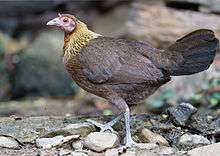

Males make a food-related display called "tidbitting", performed upon finding food in the presence of a female.[7] The display is composed of coaxing, cluck-like calls, and eye-catching bobbing and twitching motions of the head and neck. During the performance, the male repeatedly picks up and drops the food item with his beak. The display usually ends when the hen takes the food item either from the ground or directly from the male's beak. Breeding then occurs.[8] Males that produce antipredator alarm calls[9] appear to be preferred by females.[10]
They are omnivorous and feed on insects, seeds, and fruits, including those that are cultivated such as those of the oil palm.[11]
Red junglefowl regularly bathe in dust to keep just the right balance in their plumage. The dust absorbs extra oil and subsequently falls off.[12]
Flight in these birds is almost purely confined to reaching their roosting areas at sunset in trees or any other high and relatively safe places free from ground predators, and for escape from immediate danger through the day.
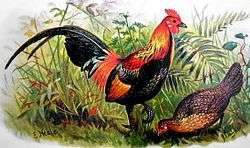
Violent sexual coercion has been observed in red junglefowl.
Domestication
In 2012, a study examined mitochondrial DNA recovered from ancient bones from Europe, Thailand, the Pacific, and Chile, and from Spanish colonial sites in Florida and the Dominican Republic, in directly dated samples originating in Europe at 1,000 BP and in the Pacific at 3,000 BP. The study showed that chickens were most likely domesticated from wild red junglefowl, though some have suggested possible genetic contributions from other junglefowl species. Domestication occurred at least 7,400 years ago from a common ancestor flock in the bird's natural range, then proceeded in waves both east and west. The earliest undisputed domestic chicken remains are bones associated with a date around 7,400 BP from the Chishan site, in the Hebei province of China. In the Ganges region of India, red junglefowl were being used by humans as early as 7,000 years ago. No domestic chicken remains older than 4,000 years have been identified in the Indus Valley, and the antiquity of chickens recovered from excavations at Mohenjodaro is still debated.[3]
Hybridisation
The other three members of the genus — Sri Lanka junglefowl (G. lafayetii), grey junglefowl (G. sonneratii), and the green junglefowl (G. varius) — do not usually produce fertile hybrids with the red junglefowl, suggesting that it is the sole ancestor of the domestic chicken. However, recent research has revealed the absence of the yellow skin gene in the wild red junglefowl found in domestic birds, which suggests hybridisation with the grey junglefowl during the domestication of the species.[2] A culturally significant hybrid between the red junglefowl and the green junglefowl in Indonesia is known as the bekisar.
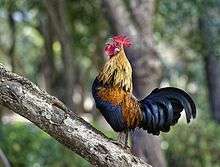
Purebred red junglefowl are thought to be facing a serious threat of extinction because of hybridisation at the edge of forests where domesticated free-ranging chickens are common.[13][14][15][16][17][18][19][20][21][22][23]
References
- ↑ BirdLife International (2012). "Gallus gallus". IUCN Red List of Threatened Species. Version 2013.2. International Union for Conservation of Nature. Retrieved 26 November 2013.
- 1 2 Eriksson, Jonas; Larson, Greger; Gunnarsson, Ulrika; Bed'hom, Bertrand; Tixier-Boichard, Michele; Strömstedt, Lina; Wright, Dominic; Jungerius, Annemieke; et al. (23 January 2008), "Identification of the Yellow Skin Gene Reveals a Hybrid Origin of the Domestic Chicken", PLoS Genetics, PLoS Genet, preprint (2008): e10, doi:10.1371/journal.pgen.1000010.eor, archived from the original on 25 May 2012, retrieved 7 November 2016
- 1 2 Storey, A.A.; et al. (2012). "Investigating the global dispersal of chickens in prehistory using ancient mitochondrial DNA signatures". PLoS ONE. 7 (7): e39171. doi:10.1371/journal.pone.0039171. PMC 3405094. PMID 22848352.
- ↑ Wild Singapore: Red Junglefowl, updated 9 October, accessed 1 January 2014.
- ↑ Collias, N. E. (1987), "The vocal repertoire of the red junglefowl: A spectrographic classification and the code of communication", The Condor, 89 (3): 510–524, doi:10.2307/1368641, JSTOR 1368641
- ↑ Evans, C. S.; Macedonia, J. M.; Marler, P. (1993), "Effects of apparent size and speed on the response of chickens, Gallus gallus, to computer-generated simulations of aerial predators", Animal Behaviour, 46 (1): 1–11, doi:10.1006/anbe.1993.1156
- ↑ Animal Behaviour Lab Dr Chris Evans, Galliform.bhs.mq.edu.au, 15 November 2006, archived from the original on 2 May 2009, retrieved 22 April 2009
- ↑ Home, Galliform.bhs.mq.edu.au, archived from the original on 11 December 2008, retrieved 22 April 2009
- ↑ "Archived copy". Archived from the original on 11 December 2008. Retrieved 4 November 2008.
- ↑ Macquarie University – Centre for the Integrative Study of Animal Behaviour, Galliform.bhs.mq.edu.au, 15 August 2008, archived from the original on 11 August 2009, retrieved 22 April 2009
- ↑ Arshad MI; M Zakaria; AS Sajap; A Ismail (2000), "Food and feeding habits of Red Junglefowl" (PDF), Pakistan J. Bio. Sci., 3 (6): 1024–1026, doi:10.3923/pjbs.2000.1024.1026
- ↑ Brinkley, Edward S., and Jane Beatson. "Fascinating Feathers ." Birds. Pleasantville, N.Y.: Reader's Digest Children's Books, 2000. 15. Print.
- ↑ I. Lehr Brisbin Jr., Concerns for the genetic integrity and conservation status of the red junglefowl, Savannah River Ecology Laboratory, Drawer E, Aiken, SC 29802 (with permission from SPPA Bulletin, 1997, 2(3):1-2): FeatherSite, retrieved 19 September 2007
- ↑ Society for the Preservation of Poultry Antiquities, archived from the original on 18 September 2007
- ↑ Red Junglefowl (Gallus gallus) page & links
- ↑ Tomas P. Condon, Morphological and Behavioral Characteristics of Genetically Pure Indian Red Junglefowl, Gallus gallus murghi, archived from the original on 29 June 2007, retrieved 19 September 2007
- ↑ Hawkins, W.P. (n.d.). Carolinas/Virginia Pheasant & Waterfowl Society. Red Junglefowl – Pure Strain, Cvpws.com, retrieved 19 September 2007
- ↑ Gautier, Z. 2002. Gallus gallus (On-line), Animal Diversity Web. Accessed 19 September 2007, Animaldiversity.ummz.umich.edu, retrieved 22 April 2009
- ↑ Genetic invasion threatens red jungle fowl, Wildlife Trust of India, New Delhi, 9 January 2006, retrieved 19 September 2007
- ↑ "Red Junglefowl genetically swamped", Tragopan No. 12, p. 10, World Birdwatch 22 (2), 1 June 2000, retrieved 19 September 2007,
According to some scientists, truly wild populations of the red junglefowl Gallus gallus are either extinct or in grave danger of extinction due to introgression of genes from domestic or feral chickens
- ↑ "Red Junglefowl – Species factsheet: Gallus gallus", BirdLife Species Factsheet, BirdLife International, 2007, retrieved 20 September 2007
- ↑ Peterson, A.T. & Brisbin, I. L. Jr. (1999), "Genetic endangerment of wild red junglefowl (Gallus gallus)", Bird Conservation International, 9: 387–394, doi:10.1017/s0959270900002148
- ↑ Brisbin, I. L. Jr. (1969), "Behavioral differentiation of wildness in two strains of Red Junglefowl (abstract)", Am. Zool., 9: 1072
External links
| Wikispecies has information related to Gallus gallus |
| Wikimedia Commons has media related to Gallus gallus. |
- Malaysian Red Junglefowl
- Red Junglefowl: Pure-bred v/s Cross-bred
- ARKive – images and movies of the Red Junglefowl (Gallus gallus)
- BirdLife Species Factsheet
- Red Junglefowl
- View the red junglefowl genome in Ensembl
- View the galGal4 genome assembly in the UCSC Genome Browser.
- Gallus bankiva (illustration) in Sir William Jardine, The natural history of gallinaceous birds: Vol. I., published by W. H. Lizars, and Stirling and Kenney, 1834; at Google Books.
- Reference guide to the four species of the genus Gallus, commonly known as junglefowl. Contains information and photographs of each of the species
- Ancestors of chickens studied for conservation; 7 August 2008; The Economic Times, Times of India
